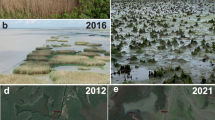Abstract
The hydrologic regime of the Illinois River has been substantially altered by floodplain levees, navigation dams, and water diversion. Unnaturally frequent and untimely water level fluctuations, large and small, have decreased the productivity of many floodplain vegetation communities that provide important ecological services, including the moist-soil plant community. We simulated three scenarios, including two that were expected to benefit moist-soil plants: (1) existing conditions, with levees and navigation dams closed during the summer growing season; (2) levees opened to reconnect the river and its floodplain during the growing season; and (3) both the downstream navigation dam and the levees opened during the growing season. A 1-dimensional hydraulic model generated daily hydrographs of the river at three positions in the 135 km study reach: (1) near the downstream dam, (2) in the middle of the reach, and (3) near the upstream dam. These hydrographs then were used to run a model that predicts the growth of moist-soil plants at a range of floodplain elevations. As expected, the model predicted that plants would grow over a larger area with levees open during the growing season than under the existing conditions, but the outcomes showed a strong location dependency. Moist-soil plant production would increase in the upper and mid-reach locations, but there would be no change near the downstream dam despite opening the levees. Modelling revealed that the existing operation of the navigation dam permanently floods most of the floodplain zone where moist soil plants might grow for at least 15 km upstream of the dam. Trees currently grow all the way to the low water line and are likely to exclude moist soil plants from any restored portion of the floodplain. Sites for reconnecting the river with its floodplain should be carefully chosen to maximize the chances of recovering the important moist-soil plant community in this regulated river.
Similar content being viewed by others
References
C. Ahn R. E. Sparks D. C. White (2004a) ArticleTitleA dynamic model to predict responses of millets (Echinochloa sp.) to different hydrologic conditions for the Illinois floodplain-river River Research and Applications 20 485–498 Occurrence Handle10.1002/rra.769
C. Ahn D. C. White R. E. Sparks (2004b) ArticleTitleMoist-soil plants as ecohydrologic indicators to recover the flood pulse in the Illinois River Restoration Ecology 12 207–213 Occurrence Handle10.1111/j.1061-2971.2004.00361.x
F. C. Bellrose S. P. Havera F. L. Paveglio D. W. Steffeck (1983) ArticleTitleThe fate of lakes in the Illinois River Valley Illinois Natural History Survey Biological Notes 119 1–27
F. C. Bellrose F. L. Paveglio D. W. Steffeck (1979) ArticleTitleWaterfowl populations and the changing environment of the Illinois River Valley Illinois Natural History Survey Bulletin 32 1–54
V. T. Chow (1964) Statistical and Probability Analysis of Hydrologic Data, Section 8-I V. T. Chow (Eds) Handbook of Applied Hydrology McGraw-Hill Inc New York 1–42
P. Clancy (2001) ArticleTitleRestoring the Illinois River Nature Conservancy 51 12–19
Demissie, M. & V. Knapp, 2000. Hydrology and hydraulics of the Illinois River. Proceedings of the 2000 Joint Conference on Water Resources Engineering and Water Resources Planning and Management. In Hotchkiss, R. H. & M. Glade (eds). Environmental and Water Resources Institute of the American Society of Civil Engineers, Reston, VA. CD-ROM
Fredrickson L. H. & T. S. Taylor, 1982. Management of Seasonally Flooded Impoundments for Wildlife. Publication 148, United States Department of the Interior, Fish and Wildlife Service, Washington, DC
D. L. Galat (1998) ArticleTitleFlooding to restore connectivity of regulated, large-river wetlands BioScience 48 721–733 Occurrence Handle10.2307/1313335
Havera S. P., 1999. Waterfowl of Illinois. Special Publication No. 21, Illinois Natural History Survey, Champaign, IL
HEC, 1993. One-dimensional Unsteady Flow through a Full Network of Open Channels. User’s Manual. U.S. Army Corps of Engineers, Hydraulic Engineering Center, Davis CA
Illinois State Water Survey, 2004. Predicted sedimentation in Emiquon. Report to the Emiquon science advisory council of the nature conservancy, April 2004. http://ilrdss.sws.uiuc.edu/search/search_results.asp?pr=500&strSearch=emiquon
Junk, W. J., P. B. Bayley & R. E. Sparks, 1989. The flood pulse concept in river-floodplain systems. In Dodge D. P. (ed.), Proceedings of the International Large River Symposium. Vol. 106. Canadian Special Publication of Fisheries and Aquatic Sciences: 110–127
T. M. Koel R. E. Sparks (2002) ArticleTitleHistorical patterns of river stage and fish communities as criteria for operations of dams on the Illinois River River Research and Applications 18 2–19 Occurrence Handle10.1002/rra.630
D. W. Schneider (2000) ArticleTitleBackwater lakes: history shows their values to Illinois Wetland Matters 5 1–11
R. E. Sparks J. C. Nelson Y. Yin (1998) ArticleTitleNaturalization of the flood regime in regulated rivers BioScience 48 706–720 Occurrence Handle10.2307/1313334
R. E. Sparks P. B. Bayley S. L. Kohler L. L. Osborne (1990) ArticleTitleDisturbance and recovery of large floodplain rivers Environmental Management 14 699–709 Occurrence Handle10.1007/BF02394719
Sparks R. E., J. B. Braden, M. Demissie, P. Mitra, D. W. Schneider, D. C. White & R. Xia, 2000. Technical Support of Public Decisions to Restore Floodplain Ecosystems: A Status Report on the Illinois River Project, USA. In Smits A. J. M., P. H. Nienhuis & R. S. E. W. Leuven, (eds), New Approaches to River Management. Backhuys Publishers, Leiden: 225–247
Thompson, J., 2002. Wetlands Drainage, River Modification, and Sectoral Conflict in the Lower Illinois Valley, 1890–1930. Southern Illinois University Press, Carbondale, IL
United States Army Corps of Engineers, 1995. Floodplain Management Assessment of the Upper Mississippi River and Lower Missouri Rivers and Tributaries Main Report, United States Army Corps of Engineers, Rock Island, IL
Author information
Authors and Affiliations
Corresponding author
Rights and permissions
About this article
Cite this article
Ahn, C., Johnston, D.M., Sparks, R.E. et al. Analysis of Naturalization Alternatives for the Recovery of Moist-soil Plants in the Floodplain of the Illinois River. Hydrobiologia 565, 217–228 (2006). https://doi.org/10.1007/s10750-005-1915-5
Issue Date:
DOI: https://doi.org/10.1007/s10750-005-1915-5




